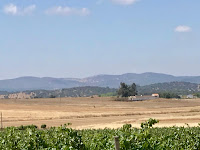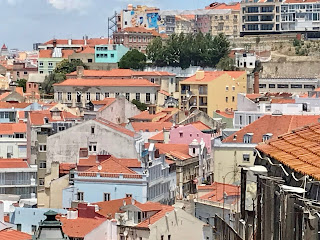6 July
 Heading back into Spain to Cáceres and the Extremadura Region today! Through the cork oak farms and olive groves, passed gypsy families and into the Alentejo vineyards. A pretty drive through Evoramonte, vineyards and farms via hilltop Alvas in the distance across Rio Caia into Spain by passing Badajoz.
Heading back into Spain to Cáceres and the Extremadura Region today! Through the cork oak farms and olive groves, passed gypsy families and into the Alentejo vineyards. A pretty drive through Evoramonte, vineyards and farms via hilltop Alvas in the distance across Rio Caia into Spain by passing Badajoz. Through farmlands and olive groves via Mérida on the River Guadiana to Cáceres and ‘Camping Ciudad de Cáceres’ (18 euros). A great camp with a difference, each pitch has its own toilet, shower and washing up basin. It has is a shared municipal pool, restaurant/bar and handy to the bus stop.
Found a nice pitch and met Doug and Di originally from The Isle of Wight and now live in Spain.
Spent the afternoon in the pool.
7 July
Had a rest day today as Pam is recovering from food poisoning, a bug doing the rounds.
8 July
 Caught the bus into Cáceres (4.20 euros for two return) and went exploring. Cáceres was founded by the ancient Romans and has had subsequent occupation by many different cultures.
Caught the bus into Cáceres (4.20 euros for two return) and went exploring. Cáceres was founded by the ancient Romans and has had subsequent occupation by many different cultures. 
Strolled into the stunning medieval old town, ‘Ciudad Monumental’. The town is encircled by twelfth century Moorish walls.
It was like walking into the set of ‘A Game Of Thrones’!
A rest day! Col is not feeling A-1, has a milder dose of what Pam had.
10 July
After farewells to Doug and Di, we hit the road! Heading to the Monfrague National Park, a forty-five minute drive. Into the rolling hills covered in oaks and barren desert surrounded by mountains and the ‘Parque Nacional de Monfragüe’. Arrived at ‘Camping Monfrague’ (18 euros) with shared municipal swimming pool, restaurant/bar. Most tourists have left this ‘neck of the woods’ by now to avoid the crowds and heat, so apart from a few locals camping here, the camp is pretty empty.
 Lefty couldn’t fit under the pitches with shade cloth however we managed to find a pitch with trees providing good shade.
Lefty couldn’t fit under the pitches with shade cloth however we managed to find a pitch with trees providing good shade.
 Lefty couldn’t fit under the pitches with shade cloth however we managed to find a pitch with trees providing good shade.
Lefty couldn’t fit under the pitches with shade cloth however we managed to find a pitch with trees providing good shade.
It’s 38 degrees, we hit the pool! Didn’t move until it began to get cooler. Gets dark around 10pm and its still pretty hot. The locals eat around 10pm and think about going to bed after midnight.
11 July
The Monfrague National Park is situated in the centre of a triangle formed by Plasencia, Trujillo and Cáceres. It’s known for its bird life and is also home to thousands of birds of prey. The Tagus and Tiétar rivers surround Monfrague and their waters carve rocky outcrops where tawny vulture colonies settle.
 Biked into the desert, a hot climb following a winding small road to Villarreal de San Carlos. The hamlet is the starting point for all walks in the Park. The Park Centre located here advised us against doing the hike we’d planned due to extreme temps and kindly organised a free shuttle.
Biked into the desert, a hot climb following a winding small road to Villarreal de San Carlos. The hamlet is the starting point for all walks in the Park. The Park Centre located here advised us against doing the hike we’d planned due to extreme temps and kindly organised a free shuttle.  Amazing views as the shuttle wound its way up a mountain to the Monfrague Castle. The castle was begun in the Moslem period and during the twelfth century suffered many sieges and changed hands a number of times which lead to its rebuilding.
Amazing views as the shuttle wound its way up a mountain to the Monfrague Castle. The castle was begun in the Moslem period and during the twelfth century suffered many sieges and changed hands a number of times which lead to its rebuilding.
We climbed to the highest point for stunning panoramic views!
 Homeward, we stopped near the Peña Falcon rocky cliff, home to a community of birds including vultures, falcons and eagles. Spotted a magnificent black vulture perched on its own rock.
Homeward, we stopped near the Peña Falcon rocky cliff, home to a community of birds including vultures, falcons and eagles. Spotted a magnificent black vulture perched on its own rock.
Enjoyed a tasty lunch back in Villarreal de San Carlos.
A fantastic day and well worth the exhausting bike ride back to camp…found out it was in 42 degrees! Lucky the vultures didn't get us!
12 July
 Left our camp in Monfrague and headed to Salamanca and the Castille and León Region, a one and a half hour drive! A picturesque drive climbing over the mountains via Lake Banos, over viaducts via Béjar and mountain villages. Signs pointing to ski fields located not too far away. Via Guijuelo and into the farmlands and cut wheat fields, oaks and fields of corn as we get closer to Salamanca. Spotted stork nests on the tops of electric power poles on the side of the road. Arrived at ‘Camping Don Quijote’ (18 euros), 7kms from Salamanca along the River Tormes. Good basic facilities, swimming pool and restaurant. Found a nice shaded pitch next to the drinking water tap.
Left our camp in Monfrague and headed to Salamanca and the Castille and León Region, a one and a half hour drive! A picturesque drive climbing over the mountains via Lake Banos, over viaducts via Béjar and mountain villages. Signs pointing to ski fields located not too far away. Via Guijuelo and into the farmlands and cut wheat fields, oaks and fields of corn as we get closer to Salamanca. Spotted stork nests on the tops of electric power poles on the side of the road. Arrived at ‘Camping Don Quijote’ (18 euros), 7kms from Salamanca along the River Tormes. Good basic facilities, swimming pool and restaurant. Found a nice shaded pitch next to the drinking water tap. Salamanca, the ancient university town was conquered by the Carthaginians in the third century B.C. and the university is one of the oldest in Europe.

Ignored the 38 degrees temp and followed the path along the River Tormes into Salamanca with its old town. A mix of modern and old. Strolled passed Gothic churches, down streets taking you back to the twelfth and fifteenth century into the stunning public square, 'Mayor Plaza’. Beautiful architecture in sandstone.
 Admired the two Cathedrals standing side by side, the new Gothic grandiose cathedral next to the old Romanesque simple more austere cathedral. Took in the university faculties, the monuments, the plazas lined with quirky eateries, student bars, restaurants, parks and gardens.
Admired the two Cathedrals standing side by side, the new Gothic grandiose cathedral next to the old Romanesque simple more austere cathedral. Took in the university faculties, the monuments, the plazas lined with quirky eateries, student bars, restaurants, parks and gardens.An energetic accordion busker added to the fun.

Enjoyed a cold drink in the centre of town and watched the eateries opening up for the night session. Caught the bus back to camp.
13 July
 A one hour drive to Tordesillas, 30kms before Valladolid! Through the cut wheat fields and patches of sunflowers via Zamora, passed the stork nests and through the vineyards and pines as we get closer to Tordesillas. Arrived at ‘Camping Elastral' (32 euros). A lovely campsite with shared pool and restaurant, good facilities and on our route to the Coast. Mid-afternoon the ‘heavens opened’, rain and a hail storm, luckily it didn’t last too long.
A one hour drive to Tordesillas, 30kms before Valladolid! Through the cut wheat fields and patches of sunflowers via Zamora, passed the stork nests and through the vineyards and pines as we get closer to Tordesillas. Arrived at ‘Camping Elastral' (32 euros). A lovely campsite with shared pool and restaurant, good facilities and on our route to the Coast. Mid-afternoon the ‘heavens opened’, rain and a hail storm, luckily it didn’t last too long. 
 Crossed over the bridge near the camp and strolled into Tordesillas situated on the banks of the River Duero. Explored the cobbled streets and took in the main square lined with eateries, fourteenth century Santa Clara Royal Monastery, Gothic sixteenth and seventeenth century churches, followed stairs leading up to view points, small squares and narrow alleyways.
Crossed over the bridge near the camp and strolled into Tordesillas situated on the banks of the River Duero. Explored the cobbled streets and took in the main square lined with eateries, fourteenth century Santa Clara Royal Monastery, Gothic sixteenth and seventeenth century churches, followed stairs leading up to view points, small squares and narrow alleyways. 

Loved all the storks nesting on top of these lovely old
buildings.
A beautiful characteristic town with a laid back vibe.
A great steak and chips dinner at the camp restaurant, finished off with an ice cream!
Interesting to note that during the Middle Ages Tordesillas was a Royal Estate and reached its historical peak in 1494 when the Tordesillas Treaty was signed by the kingdoms of Castille and Portugal. The Treaty was signed to establish geographical limits of each crown with respect to land in the American continent that had been discovered or was to be discovered in the future. It divided the Atlantic Ocean down the middle, Castille was to have the Western hemisphere and Portugal the Eastern hemisphere. In this way, with mediation, an agreement could be made regarding which conquests each nation could make in the New World.
The sixteenth century was marked by the forty-six year long stay of Joan I of Castile in Tordesillas. During this time, kings, queens and nobility came to the village to visit the Queen.
14 July
Heading to our next overnight camp about 20kms from Vitoria-Gasteiz. A 257kms drive in the Basque Region!
Passed the ‘Camino de Santiago’ signs and over the River Duero into the cut wheat fields, oaks and agricultural farming, patches of sunflowers and ancient villages. Cyclists are enjoying the small roads through the farmlands. Via Valladolid, Dueñas, Palencia (no signs of the flooding here two days ago), Burgos surrounded by mountain ranges.
Over the River Ebro via Miranda, along small rural roads to ‘Camping El Roble Verde’ in the hills, ten minutes drive from Pobes. Has heated swimming pool, restaurant/bar and playground. There are walking and mountain biking tracks that start by the camp.
Over the River Ebro via Miranda, along small rural roads to ‘Camping El Roble Verde’ in the hills, ten minutes drive from Pobes. Has heated swimming pool, restaurant/bar and playground. There are walking and mountain biking tracks that start by the camp.
Col reading from his phone blow by blow World Cup Cricket action, NZ vs England!
Heading to France tomorrow.
We've had an awesome time in Spain and Portugal! Lovely laid back people, amazing and charming scenery, yummy food, great weather and cost effective.

























































